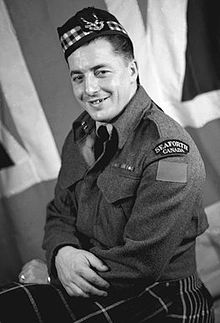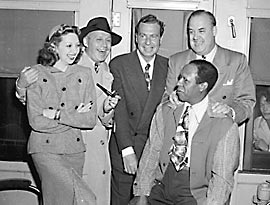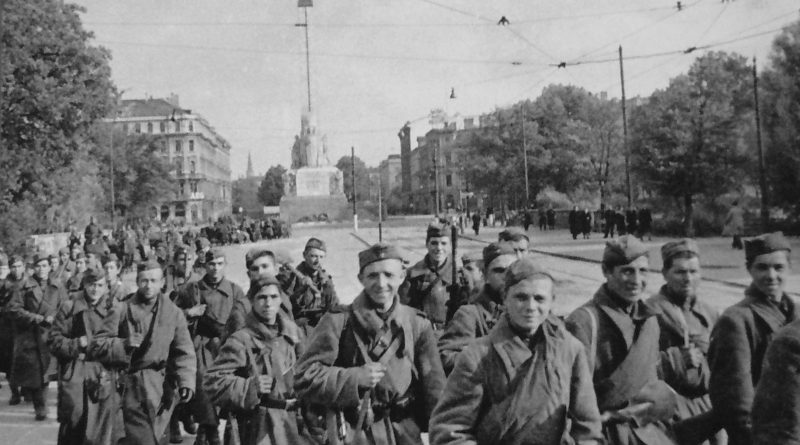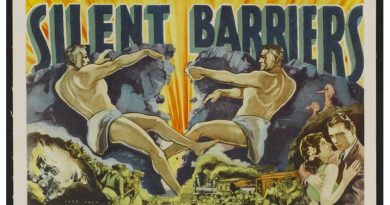Events of 1944
D-Day, June 6, 1944 is a date virtually everyone knows: it marked the invasion at Normandy. More than a thousand Allied planes and gliders began dropping paratroopers into Normandy in the dark hours before dawn. The push to recapture the Nazi-occupied continent was under way. Optimism about the course of the war began to grow.
And on the home front that same June day? The Orpheum was showing a movie musical, Broadway Rhythm, with Tommy Dorsey and his orchestra. Orpheum manager Ivan Ackery had arranged for Dal Richards’ 20-piece orchestra from the Hotel Vancouver to appear on the Orpheum’s stage to accompany, in person, the singer Adriana Caselotti. Caselotti had been the voice of Snow White in Walt Disney’s great 1937 feature-length cartoon. Ackery took her, and actors dressed as Pluto, Grumpy and Goofy, to perform for the veterans at Shaughnessy Military Hospital and they loved her.
Out at the airport, Vancouver’s Boeing plant was busy. You get a nice feel for the times with this reminiscence by an unnamed former Boeing employee. She’d been hired as a gofer in 1944, and told a local web site: “I delivered radio parts to the ships [aircraft] and if the guys wanted nuts or bolts and other parts I’d go for them, hence the term gofer. You needed good footwear to work on that huge plant cement floor . . . and of course the stores [the shop] was located across the way in the other building up the stairs, so your feet were pretty sore by the end of the shift. I started at 40 cents an hour and finished at 80 cents an hour in Shop 63. I was making more money than my father at the time, who was making 60 cents an hour at Pacific Mills. My husband came from Montreal and was a Boeing electrical inspector at Plant 3 from 1944 to 1945. I lived in Vancouver and had to transfer about five times before reaching Marpole to catch the Boeing Bus. We called it the ‘Cattle Car.’ We weren’t fortunate enough to obtain accommodation in the new Burkeville subdivision being built for Boeing employees, as it was designed for employees with families.”
Wartime wages were causing other anomalies: in Surrey, for example, school teachers asked for a pay raise. It seems students with summer jobs in war industries were making more than they were.

1944 marks the dramatic entry into local history of New Westminster’s Ernest Alvia “Smokey” Smith. On October 21 Smokey, a Seaforth Highlander, aged 30, won the Victoria Cross for bravery in action in northern Italy. The VC is the highest and most prestigious award for gallantry in the face of the enemy that can be awarded to a soldier in Commonwealth forces.
The citation of what Smokey did makes for exciting reading. Here’s an excerpt: “Under heavy fire from the approaching enemy tanks, Private Smith, showing great initiative and inspiring leadership, led his PIAT group of two men across an open field to a position from which the PIAT could best be employed. [PIAT: Projector Infantry Anti-Tank.] Leaving one man on the weapon, Private Smith crossed the road with a companion and obtained another PIAT. Almost immediately an enemy tank came down the road firing its machine-guns along the line of the ditches. Private Smith’s comrade was wounded. At a range of thirty feet and having to expose himself to the full view of the enemy, Private Smith fired the PIAT and hit the tank, putting it out of action. Ten German infantry immediately jumped off the back of the tank and charged him with Schmeissers [submachine guns] and grenades. Without hesitation Private Smith moved out on the road and with his Tommy gun at point-blank range, killed four Germans and drove the remainder back. Almost immediately another tank opened fire and more enemy infantry closed in on Smith’s position. Obtaining some abandoned Tommy gun magazines from a ditch, he steadfastly held his position, protecting his comrade and fighting the enemy with his Tommy gun until they finally gave up and withdrew in disorder.
“One tank and both self-propelled guns had been destroyed by this time, but yet another tank swept the area with fire from a longer range. Private Smith, still showing utter contempt for enemy fire, helped his wounded friend to cover and obtained medical aid for him behind a nearby building. He then returned to his position beside the road to await the possibility of a further enemy attack. No further immediate attack developed, and as a result the battalion was able to consolidate the bridgehead position so vital to the success of the whole operation, which led to the capture of San Giorgio Di Cesena and a further advance to the Ronco River.
“Thus, by the dogged determination, outstanding devotion to duty and superb gallantry of this private soldier, his comrades were so inspired that the bridgehead was held firm against all enemy attacks, pending the arrival of tanks and anti-tank guns some hours later.”
By December, the Province reported, Smokey “wants to get home to New Westminster. He has his Victoria Cross. The excitement of a private investiture at Buckingham Palace is over. Now he’s getting impatient. ‘Five years is a long time to be overseas,’ Canada’s first buck private to win the VC in this war, said in a London interview today.” (December 21).
On the same day Smokey won his VC, here in Vancouver HMCS Discovery, a naval training base, was officially opened on Deadman’s Island. The members of the Royal Canadian Naval Volunteer Reserve had been housed since November of 1941 in the Stanley Park Barracks. They welcomed their spacious new home. During the Second World War, Discovery—which had a ‘population’ that occasionally reached 1,000—would be a major source of naval recruits in Canada, giving us 372 officers, 6,974 ratings and 650 WRENS (the name given to members of the Women’s Royal Naval Service). Because the base is land-locked and not an actual sea-going ship, it and others like it is by naval tradition called a “stone frigate.” So her crew refers to Discovery as a ship.
Another ship, this one sea-going, was active this year. Quietly and without notice the little RCMP schooner St. Roch left Halifax July 22, 1944 to return to Vancouver through the Arctic. Her trip west was markedly faster than her 1940-1942 push to the east: that had lasted two years and four months. This time, using a more northern route, and in deeper waters, she made it back in just six days short of three months—becoming, incidentally, the first vessel to make it through the northwest passage in one season, and the first to go through in both directions. The little ship arrived October 16. (And years later, after a voyage through the Panama Canal, the St. Roch would become the first ship to circumnavigate North America.) The 95-foot schooner was captained by Sgt. Henry Larsen.
The local attitude during the war toward the Japanese who had lived in this area before their 1942 expulsion is captured in a remark made by Ian Mackenzie, MP for Vancouver Centre, the former minister of national defence (and, as minister of pensions and national health, the only British Columbian in the federal cabinet.) At his nomination meeting this year Mackenzie suggested: “Let our slogan be for British Columbia: ‘No Japs from the Rockies to the seas.’” Mackenzie was a regular supporter of anti-Asian legislation.
And lest the reader think I’m being holier than thou, I’ll tell you that in 1944 my father shared the same sentiments. I’d be astonished to learn that, at age 9, I didn’t, as well.
On August 14 Vancouver City Council adopted Odessa in Ukraine as a sister city. Odessa had been cleared in April by the Russian army of occupying German and Romanian troops, and to mark the occasion, the Vancouver Symphony Orchestra gave a concert of Russian music. (Ukraine was, of course, part of the Soviet Union at the time.)
One small local outcome of the war was the creation of the Restaurant & Foodservices Association of B.C., still active. It was formed to deal with problems created by rationing!
On August 15, 1944 radio station CKNW signed on (unofficially) at 1230 on the dial—the 980 frequency was in the future—with 250 watts of power, after on-air testing which had started April 1. It was the only radio station in Canada to sign on during the war. Its owner, Bill Rea, would launch many innovations on his new station: hourly newscasts, on-air 24 hours a day, all music, the Orphans’ Fund and man-on-the-street interviews. NW is still the top-rated radio station in the Greater Vancouver area.
What an impact Bill Rea made on local radio! And what unpromising beginnings! CKNW was a tiny station on the second floor of a nondescript hotel in New Westminster (far from the big boys in Vancouver) that played “cowboy” music. Rea started hourly newscasts—a local first—because he knew we wanted news of our troops overseas; he kept NW on 24 hours a day, another first; he started a people-on-the-street show called Roving Mike that lasted for decades, and he initiated the Orphans’ Fund that has raised millions for local kids. Look for the 1994 book Top Dog! It tells the story of this remarkable station.

Radio made local news on April 23 when Jack Benny did his famous show from Vancouver. He brought his regular cast up from New York: Mary Livingstone, Phil Harris, Rochester, Dennis Day and announcer Don Wilson. What made the show particularly notable was that the Seattle-born Mary Livingstone (real name Sadie Marks) had grown up in Vancouver. Old timers will recall that Mary got a lot of comic mileage about Jack’s age. He was forever 39.
That led to exchanges like this:
Jack: You know, Mary, being in Vancouver brings back memories to me, too. When I was in vaudeville, I played the Orpheum Theatre many a time. Did you know that?
Mary: Did I know that? Jack, every time you played here didn’t you notice a little girl in the third row in the aisle seat, with long blonde pigtails and a pink ribbon in her hair?
Jack: Well, I’ll be darned! Was that you?
Mary: No, that was my mother.
Jack: Now cut that out!
A little later Vancouver mayor Jack Cornett popped in as a special guest and Jack began to pester him about the toll charge (25 cents) on the Lions Gate Bridge. Jack wondered if it might be possible to drop the toll so that he could see Grouse Mountain up close, instead of always through his telescope. Then the mood got serious for a moment as Jack echoed Mayor Cornett’s plug for Canada’s Sixth Victory Loan, a fund-raising campaign to help the war effort.
Benny would visit Vancouver often, and was successful many years later in helping to raise funds to save the Orpheum Theatre.
A lot of famous folk were involved in persuading us to buy war bonds. Golfing great Ben Hogan participated this year in a wartime fund-raiser at Shaughnessy Golf Course.
The man who had been at the helm of UBC for 25 years stepped down in 1944. Leonard Klinck had joined the university in 1914 as Dean of the Faculty of Agriculture. After the sudden death in 1918 of President Frank Wesbrook, Klinck was appointed to the presidency in July, 1919. “He successfully oversaw the building of the Point Grey campus and the formation of a renowned and spirited faculty.” Klinck was succeeded as president by Dr. Norman A.M. MacKenzie, who would prove to be one of the university’s more popular leaders.
MacKenzie, after service in the First World War, studied law at Dalhousie, Harvard and Cambridge universities, then went into practice. He later joined the University of Toronto to teach law, and was president of the University of New Brunswick before becoming president of UBC.
Dr. R. E. McKechnie, the university’s chancellor since 1918, died in office on May 24, aged 83, and was succeeded by Eric Hamber. Hamber, president of the BC Mills Timber and Trading Company, had recently been a popular BC lieutenant-governor.
Harry Letson donated thousands of engineering books and periodicals to UBC this year.
The B.C. Research Council, founded by the BC Provincial government, began on the UBC campus. Its mandate was “to operate laboratory facilities, conduct industrial research, and help develop technologies believed to be important to British Columbia.” The Council would become a catalyst for innovation in the province. It would be taken private in the early 1990s after running into financial difficulties.
The Vancouver Foundation was formed this year under chairman W.J. VanDusen. The Foundation’s web site tells us that a little-known woman by the name of Alice G. MacKay sparked the idea. Ms. MacKay had saved $1,000 from her secretarial job (a lot of money for a working woman in 1944) and wanted to do something special for Vancouver, “particularly for homeless women trapped in a cycle of poverty. “ VanDusen, an industrialist/philanthropist, decided to make her wish come true.
“A man of great vision,” the Foundation continues, “Mr. VanDusen had understood the potential of building a permanent endowment that could benefit many charitable activities. As Director of the Vancouver Welfare Federation (now the United Way of the Lower Mainland) and Chair of its Endowment Committee, he had studied models of community foundations for several years. And by 1943, he had overseen the establishment and incorporation of Vancouver Foundation. However, at the time of Alice MacKay’s death in 1944, Vancouver Foundation was nothing more than a legal entity with virtually no capital and was therefore a community foundation in name only.
“Inspired by Alice MacKay’s bequest, Mr. VanDusen encouraged nine friends to match his gift of $10,000 and the rest is history.” So Ms. MacKay’s $1,000 quickly turned into $100,000 thanks to VanDusen and his friends. Today the Foundation has $565 million on its hands.
A meeting room in the main branch of the Vancouver Public Library is named for Ms. MacKay.
In local business news, volume at the wartime Vancouver Stock Exchange bottomed at 11 million shares this year, with brokers devoting themselves to selling Canadian government Victory bonds. And North Vancouver City finally emerged from receivership, which had started in 1933 during the Great Depression.
An important new company emerged here in 1944. The engineering firm of H.A. Simons (started by Howard Simons) was formed to serve the forest products industry. The history of the company is interesting: it can be traced back to 1914 in Chicago. A man named Venning Dodge Simons established an industrial engineering firm there, and within a couple of decades had been involved in the design and construction of some two dozen paper mills in a half dozen American states and British Columbia.
In the early 1940s BC lumber magnate Prentice Bloedel asked Simons to build a pulp mill in Port Alberni on Vancouver Island. But Simons, 70, said he was too old to undertake the job himself, and instead sent his son, Howard . . . better known as H.A. The new company took on that Port Alberni project, building the mill for Bloedel, Stewart & Welch. It was the first kraft pulp mill in B.C. H.A. Simons would thrive in the years to come, often being number one in the world in the field of building lumber mills. The company would be purchased in 1999 by the big engineering firm, AGRA. By that time it had completed more than 10,000 projects in more than 70 countries. (Later, AGRA would merge with the huge UK firm AMEC.)
On September 30 BC Bearing Engineers Ltd. was incorporated in Vancouver, founded by Robert A.S. MacPherson. MacPherson had started a company called Northern Metals and Engineering in 1936, and in 1942 opened a bearing store at 1393 Granville. The company flourished. Today the BC Bearing Group has nearly 60 locations worldwide and annual sales of more than $200 million.
An ambitious young woman of 17, Grace Winterbottom opened a little flower shop in December, 1944 in an abandoned storefront on East Hastings Street. A few weeks later she had netted $700—a neat profit for the time—and used that money the following February to open a bigger, better store one block west. Grayce Florists (her sister Nona suggested adding the ‘y’) flourished. We know the lady today as Grace McCarthy.
Beer magnate Emil Sick of Seattle bought Athletic Park, where baseball’s Capilanos played, and renamed it Capilano Stadium.
Leonard Frank, the photographer, died February 23, 1944, aged about 74. He came here from Germany in 1892, age 22, looking for gold, but that didn’t work out. Then he won a lottery in which first prize was a camera. Frank’s father was a professional photographer, and taught the craft to young Leonard. So he began to take pictures. For 50 years he took pictures. His nearly 50,000 images captured a now-vanished British Columbia with astonishing clarity and beauty. I swear you can see the stubble on the lumberjacks’ cheeks. Enjoy this extraordinary body of work in Cyril Leonoff’s multi-award-winning 1990 book Leonard Frank: An Enterprising Life.
Charles Hill-Tout, ethnologist, died in Vancouver June 30, aged 85. He was born September 28, 1858 in Buckland, England, came to Canada in 1884, and arrived in Vancouver in 1890. It was Hill-Tout who realized Vancouver’s Marpole Midden was the largest of its kind in North America. He founded his own school, Buckland College, on Burrard Street. After approximately a decade at Buckland, Hill-Tout gave up education and moved to a farm in the Abbotsford area, where he subsequently opened and operated a mill producing railway ties for the CPR. “A devoted amateur anthropologist,” Constance Brissenden wrote, “he focused on the Salish Indians of B.C. He was elected to the Royal Society of Canada in 1913, later became the president of its anthropological section. He was a president of the Art, Historical and Scientific Association of Vancouver [precursor to the Vancouver Museum], which published his Great Fraser Midden in 1938. His field reports were collected as The Salish People by Ralph Maud (1978). Asked by the CPR to name a new subdivision in Vancouver, Hill-Tout suggested Kitsilano, a modification of the name of the chiefs of the Squamish Band. He is the author of The Native Races of British North America: the Far West (1907).”
In entertainment news: Vancouver-born Yvonne de Carlo (real name Peggy Middleton) was named the “most beautiful girl in the world.” Her studio gave her the title, so they may have been a little prejudiced. The White Rock Players acting troupe was formed, and Mart Kenney’s Western Gentlemen orchestra was hugely popular. “I was the Bryan Adams of 1944,” Mart once said.
Fragments
On September 15, 1944 a new product called “contact lenses” arrived in Vancouver.
Winnipeg shopkeeper George Davis and his son Charlie arrived in Vancouver in December, and the elder Davis got a job as a loader at Dairyland. Nine-year-old Charlie (now ‘Chuck’) will become a broadcaster and writer.
Local Doukhobors held a prayer vigil on the Courthouse steps for 13 of their brethren imprisoned in Oakalla.
A forest fire swept down Black Mountain in West Vancouver, covering seven square miles, and was finally stopped just 300 yards above Eagle Harbour.
Les Gilmore of Richmond harvested 900 bushels of potatoes per acre, the highest yield per acre in Canada.
The Children’s Health Centre was built at Vancouver General Hospital.
The Malahat, which during the U.S. prohibition era became known as the “Queen of Rum Row,” was wrecked. In her heyday she often sailed with 60,000 cases of liquor on board.
Munich-born Erwin Swangard, 36, became foreign editor of the Province, a post he would hold for five years before going to the Sun with the same title.
Edgar George Baynes, 74, was named Vancouver’s Good Citizen for 1944. Major Matthews’ citation, read at the December 5 investiture: “A stalwart pioneer of vision, courage and energy. A man of sympathy, goodwill and generous in thought and deed. Volunteer soldier (corporal), first military unit in Vancouver, 1894-99. Park Commissioner, 1924-38 inclusive, fifteen years. Warden, Holy Trinity Church. President, B.C. Historical Association, Port Haney Brick Company. Member of many organizations devoted to public service.”
A streetcar strike at BC Electric in 1944 lasted three weeks, and in the absence of transit a lot of people got to work by hitchhiking.


![Hudson Bay Company - [clerks behind a display of Christmas cards on the] mezzanine](https://vancouverhistory.ca/wp-content/uploads/2021/01/b44f5b45-77b6-4a15-920a-c7918a7bcf11-A05040-390x205.jpg)

![RMS Empress of Japan in original appearance [Image: Wikipedia]](https://vancouverhistory.ca/wp-content/uploads/2021/01/1280px-Empress_of_Japan_docked_at_Vancouver_circa_1930s-390x205.jpg)